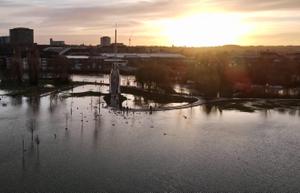Subscribe to our newsletter
Sign up for the latest news & offers from SafeSite
Quick and competitive quotes. Nationwide coverage
Quick quotes. Nationwide coverage
According to Aviva data* nearly 1 in 3 commercial properties are at risk of flooding. Despite this data, 75% of SMEs do not have a continuity plan that addresses climate change and its risks. Just 38% of businesses have flood insurance, and less than a 5th have put protective measures in place.
At this early stage, it seems that we will not be in for a very cold winter. There are also no predictions for above-average rainfall this year, although experts say it’s too early to tell, and there will be regional differences. The likelihood of being taken by surprise is also much lower nowadays because weather and surge forecasting systems have improved greatly in recent years.
That said, as we saw in 2021, and in previous years, the UK frequently sees deluges that deliver rapidly rising water levels in some areas, in very short timescales. During Storm Barra in December 2021, areas of the UK recorded 14mm falling in just three hours!
The UK has seen many other big flooding events since the start of the 21st century**. The global temperature has risen by about 0.7 °C since pre-industrial times and a warmer atmosphere can hold more moisture. Many studies into heavy rainfall events and flooding in the UK found that the probability of flooding or sudden extreme rainfall is enhanced by atmospheric circulation and climate change.
Britain’s largest recorded rainfall was 10 years ago. The jet stream tended to lie to the south of the UK through much of that year and resulted in low-pressure systems bringing rain and strong winds. That the Summer UK experienced 203% of the average rainfall for the UK.

According to the Environment Agency, around 5.9 million properties or 1 in 6 homes – are at risk of flooding across England. It’s vitally important to go online and check if your property is at risk.
You can sign up for alerts on either the Environmental Agency or Met Office sites and subscribe to alerts that affect your area of the UK. You can also use this service to keep an eye on an area important to you – perhaps where you have vulnerable friends or family, or perhaps even a family home.
Rest assured, the government is doing its bit. In the 2020 budget, the UK Government doubled its investment in flood and coastal erosion scheme construction in England. They committed a record £5.2 billion to be invested between 1 April 2021 and 31 March 2027. More information on the UK Government’s flood and coastal erosion risk management (FCERM) scheme, is available here. Existing EA flood defences have helped to protect nearly 200,000 properties during flooding incidents since 2019; the most obvious measures including flood walls, embankments, and barriers, which have reinforced UK waterways.
The coast
Tidal flooding, particularly in a century that’s already seeing rising sea levels, can result in the gradual destruction of sea defences and the loss of permanent homes to the sea. Areas of the UK particularly vulnerable to this type of flooding include:
Properties located near rivers are doubly at risk when the weather turns wet and the seasons stormy: tidal surges coming upriver from the sea, as well as rivers bursting their banks from significant rainfall over a short, sudden period. Areas of the UK at particular risk include but are by no means limited to:
Surface water flooding happens when the rainfall exceeds the capacity of drains and other surface water sewers. Areas that are frequently affected by surface water floods are:
If you are affected by flooding, consult your local authority to see whether you are eligible for Council Tax Relief and Business Rate Relief. Following periods of extreme flooding, the UK Government often makes special grants and funding available.
You can check the long-term flood risk of an area here on the government website: www.gov.uk/check-long-term-flood-risk. Once you have identified your site at risk of flooding then we advise that you put a contingency plan in place.
We provide a range of flood defence systems to help you to ensure the safety of your property, staff, and customers. If the worst has already happened and you, then you may find the following articles useful:
Do not let the risk overwhelm you. Please contact us to learn more about our range of flood defences.
Our team understands that when you contact us, you may not know what it is specifically that you need. We offer free no obligation quotes for this reason. We will help you navigate the options available and propose the right solution for you. We operate and deliver nationwide.
Sources: * Aviva Flood Mapping Data 2016-2021, **Elsevier
We respond in under 30 mins on average (excl. weekends)